abstract
with the availability of reasonably cost-effective servers, computing facilities and a fairly reliable and wide spread telecommunication and data network infrastructure, the emergence of "virtual technological institution" is a distinct reality. in this paper we present a model which has been used to implement the features of the conventional education system over internet.
key words: virtual university, virtual classroom, multimedia tool, video conferencing, whiteboard, software solution
1. introduction
quality education to increasingly large and diverse student population is posing serious problems for academia, especially in the developing world where sufficient infrastructure is yet not in place. a case under consideration is the acute shortage of quality manpower to take care of various facets of the it industry. the internet and information technology, which have unleashed unprecedented changes in all walks of life including making inroads in higher education sector, may be harnessed to solve the problem.
specifically, the demand of the time is: 1) how to provide quality education to a large set; and 2) how to improve the efficiency of the delivery for the purpose. many researchers all over have addressed to these issues. numerous solutions have been provided ranging from a simple local bulletin board system to that based on global internet and world wide web.
a very important ingredient of any solution to a technological university is the requirement of a powerful interaction in the form of group activity and the feedback from the participants. keeping all these factors in mind we have attempted to implement a virtual university concept.
in this paper we present a model, which mimics all the functionalities of a technological university. in section 2, we describe the model. section 3 covers the implementation. the management system is described in section 4. features of the virtual classroom are listed in section 5.
2. the model
in a conventional system a student enrolls for a certain number of courses, attends lectures, asks questions, listens to his fellow students asking questions, participates in a discussion, submits assignments and appears at examinations to earn credits. we have developed a system over microsoft windows platform providing a truly interactive live session between the teacher and the students. the interaction is through text, viewgraphs, graphics, free-hand drawing/writing, voice, audio and video. a database server with database manager (sql) provides web-based administrative chores like registration, browsing of lecture materials and downloading of pre-recorded lectures etc. lectures are given from a teacher's console and received on students' consoles and imitate a real classroom scenario.
we have implemented this model which is currently undergoing field trials. in this paper we describe the model and it's implementation. fig1.
gives a typical model of functioning of conventional brick and mortar institute. fig 2. presents the model, which mimics the conventional institute of fig1 in a software solution using underlying internet technology.
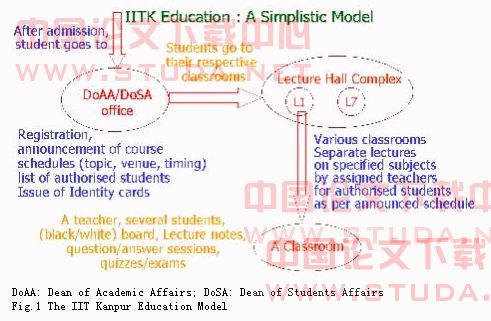
3. the implementation
the remote tutor is a complete solution for implementing virtual institute over internet. it consists of two parts, a multimedia tool which resembles a virtual classroom over a network and an administrative server called lecture manager server (lms). while lms takes care of all administrative and management related function of an e-learning enterprise, the multimedia tool is used for multiple concurrent sessions of virtual classroom.
the lms is implemented over an nt or unix server and requires an ftp server, web server and database server for complete operation of lecture manager server. the lms software constitutes of scripts, which implement the different functionality, offered by the lms server.
the administrator of the virtual university controls the registration of tutor and students with the server. depending on the availability of the teachers, the courses are floated by the administrator of the virtual university. a new teacher can apply for registration through web-based access to the virtual university server. after registering with the server, a new tutor can select to offer any of the existing lists of courses or a new course subject to approval by the administrator of the lms.
when a student registers with the virtual university by filling up the registration form through web based access to the server, he also selects the list of courses he wishes to register for, taking care of time-table clash etc. he has to satisfy the prerequisites for registering a course. once the student/tutor is registered with the server, they get access to number of features available with the server, which are listed in detail in section 4.
for attending the virtual classroom a student or a tutor needs a multimedia pc with sound card and video camera. the classroom application has been designed over microsoft windows platform. when a tutor/student joins the session (virtual classroom) by invoking the multimedia application of the remote tutor, the application, the list of live sessions or sessions to start is shown by the application. this is obtained from the session info being sent on a predefined multicast address by the server using the session description protocol.
the user selects the session and gives the login-id and the password, which is authenticated by the lecture manager server. after authentication, the application obtains the multicast address for the selected session, the encryption key and other information related to the session from the server. a session in itself is an independent entity as is a class in a real institute. fig. 3 gives a description of the interactionbetween the lecture manager server, the tutor application and the student application.
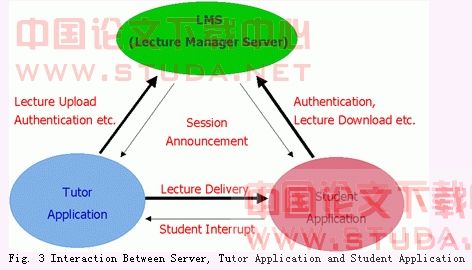
within a session the interaction is like a real classroom. whatever the teacher writes on a whiteboard is visible to all students in a session. the lecture, delivered using the
multimedia tool, consists of tutor's video, voice, viewgraphs freehand etc. section 5 gives the detailed description of the various features of multimedia tool. the most
important aspect of this tool is the live interaction between the participants in the virtual classroom. students are eligible to ask questions by interrupting the teacher.
4. lecture manager server
lecture manager server is a dedicated server, which provides all the administrative, and management functionality for implementing an e-learning solution. fig. 4. gives the
architectural view of the lecture manager server.
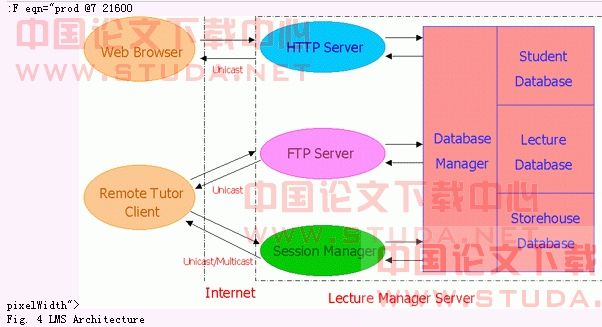
the functions of lecture manager server may be divided into following categories:
administrative functions
· maintenance of tutor, student and course database. this database consists of all the information related to a student/tutor, the performance of a student in the courses he/she has registered, grading, archive of recorded lectures for each course, home pages for each course for reference material on topics covered in a course.
· on-line registration support. both students as well as teachers can register with the server through web-based interface by filling up the appropriate registration forms.
· database backup
tutor support
· personal space. this space is provided for teachers to host their personal web-pages on the server.
· teacher is also responsible for maintenance and development of the course-page for all the courses he/she is teaching.
· upload and download of lecture material, recorded lecture on the server.
student support
· disk space for personal stuff
· download lecture/recorded material
· course based discussion/chat rooms for after class discussion among the students.
· course query, query about teachers and other students.
courseware management
· providing home pages for lectures.
· providing features for course scheduling.
· providing features for organizing lecture files
· providing mechanism to send feedback to the teacher or the server administrator
· conducting online examinations.
virtual classroom session support
· session announcement
· student/teacher authentication support
· upload/download of lecture material/recorded lecture
· maintenance of multicast group1
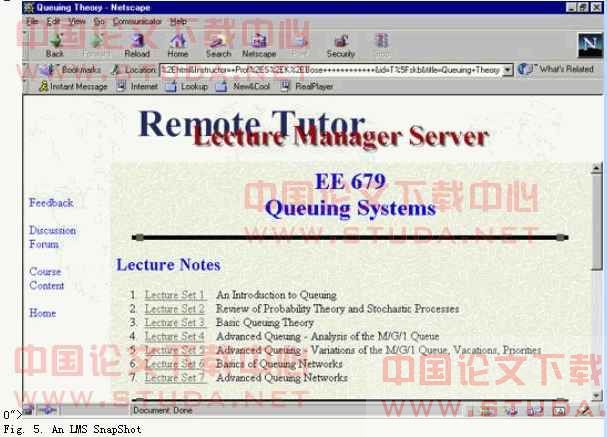
it requires server class system with database management system depending on the size of the database.
5. multimedia tool
the multimedia application is a teleseminaring tool that simulates the virtual classroom over internet. it provides a truly live interaction between the teacher and the students. the interaction is through text, viewgraphs, free-hand drawing/writing, audio and video. though this component has been designed to operate in conjunction with the lms server, it can also be used in stand-alone mode for delivery of a seminar over internet. fig 6 gives a screenshot of the user interface of the multimedia tool.
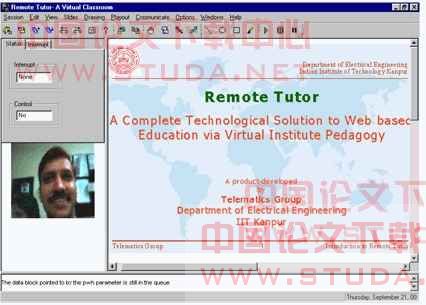
fig. 6 a snap shot of multimedia tool
lecture is delivered from a teacher's console, on the same lan or connected over a wan. when a teacher/student joins the session, the application authenticates the user with the
lms. this authentication procedure results in the application obtaining the multicast address and encryption key for the selected session. these are used by the application to
join the session.
the floor control is always with the tutor. the tutor may deliver a live lecture or may playback a pre-recorded lecture. recording and playback of lecture are built-in features
of the remote tutor multimedia tool. the multimedia application provides complete support for organizing the lecture material for smooth delivery of lecture. students can
interrupt the teacher and ask questions to initiate discussion. the speaker’s video and audio is delivered live over internet and is bandwidth efficient as it uses multicast
transport.
a lecture may consist of multiple slide files (.doc. .ppt etc) organized as units, audio files (such as .avi, .wav, .mp3) and video files (.mpg) etc. the recorded lecture
consists of teacher's audio and video, the commands for sequencing the lectures and slides and objects as part of the lecture
whiteboard part of the multimedia tool allows the flexibility of classroom environment where the teacher may use the slides for delivery of lecture and/or may use the
blackboard/whiteboard for free-hand writing/drawing. using the pointing devices like electronic pen, the white-board may be used for drawing figures such as circles, ellipse,
text, boxes, random lines, writing equations. the slide files are opened into the whiteboard part of multimedia tool. tutor can browse between the slides, annotate on the pages
and use different color and pen width for writing on white-board.
a student may request for a discussion by interrupting the teacher. interrupt message pops up on teacher's console along with the sender's indentity. teacher may postpone,
cancel or acknowledge the interrupt. once the teacher acknowledges a request from a student, student receives the control. student multicasts his query and returns the control
when over. the teacher can take back control at any time.
the whole framework is built over udp/ip support. it requires ip-multicast support for implementing virtual classroom. the h.323 compliant stack takes care of delivery of real-
time data (audio, video and voice).
6. conclusion
in this paper we have shown the implementation of virtual technological university using software solution over internet. the proposed solution matches the functionality of the
conventional brick and mortar university feature-by-feature. this model is currently being tested for its efficiency in delivery of synchronous as well as asynchronous
education.
references
1. anderson, t., “the virtual conference: extending professional education
in cyberspace. intl j. education telecommunications, 2(2/3), pg. 121-135, 1996.
2. berge, z. & collins, m., “computer mediated communication and the online classroom (vols 1-3). creekill, n-j: hampton press. 1995
3. atkinson, d., “virtual universities could be on the way”, internet magazine, april 1997, pg 17.
4. cybered home page, http://www.umassd.edu/cybered/distancelearninghome.html
5. remote tutor page, http://www.iitk.ernet.in/telematics/research/products/remote
6. gupta, m., “slidetalk: slide display implementation”, m.tech thesis, department of electrical engg., i.i.t. kanpur, april 1997.
7. kumar, sudheer n.v., “remote tutor: organising, recording & playback of lectures”, m.tech. thesis, department of electrical engineering, i.i.t. kanpur, march, 1988.

